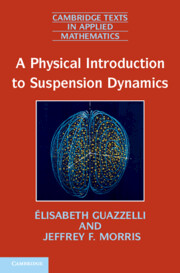5 - A short presentation of statistical and stochastic concepts
Published online by Cambridge University Press: 05 June 2012
Summary
In Part I, we have presented the basis of microhydrodynamics. In its broad definition, microhydrodynamics represents the theory of viscous fluid flows at small spatial scales. For the purposes of the present book on suspensions, we have specifically considered the single- and pair-body dynamics of small particles immersed in viscous fluid. In Part II, we will describe macroscopic phenomena encountered in flows involving a large number of particles interacting through viscous fluid. We will also provide an introduction to methods developed for understanding and (hopefully) predicting certain macroscopic phenomena in suspensions in terms of the microscopic concepts described in Part I, combined with ideas that fall in the realms of statistical physics and dynamical systems.
In this transitional chapter, we are concerned primarily with introducing statistical techniques and concepts from stochastic processes which we will apply in the following chapters. We will also briefly consider the related issue of chaotic dynamics.
Statistical physics
The theoretical framework for relating microscopic mechanics to macroscopic or bulk properties is statistical physics or statistical mechanics. Understanding systems made up of many interacting particles is far from trivial, and the difficulty involved is not just a mere question of solving the hydrodynamic equations with better, faster computers. The collective interactions between the particles can give rise to quite unexpected qualitative behavior, often much simpler than the microscopic motions seem to suggest.
- Type
- Chapter
- Information
- A Physical Introduction to Suspension Dynamics , pp. 105 - 124Publisher: Cambridge University PressPrint publication year: 2011



